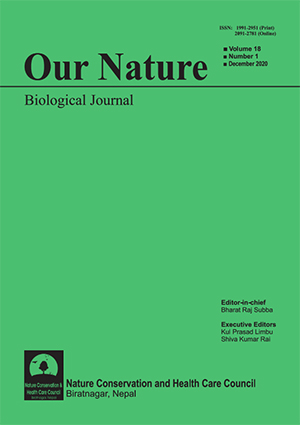Fish Assemblage Structure and Environmental Correlates in Nepal’s West Rapti River, Banke
DOI:
https://doi.org/10.3126/on.v18i1.34239Keywords:
Environmental variables, Fish assemblage, Fish diversity, Rapti River, Spatio-temporalAbstract
The spatial and temporal variations of fish assemblages in rivers and streams of Nepal are poorly understood. So, the present study aimed to explore the spatial and temporal variations of fish assemblage structure in Nepal’s West Rapti River. The data were collected during autumn, winter and spring seasons, from October 2018 to April 2019. Fish samples were collected using cast net of 12 mm mesh size. A total of 28 species belonging to 7 orders, 10 families and 19 genera were recorded during the study. The analysis of similarity (ANOSIM) showed no significant difference among the stations and seasons. Based on cluster analysis, two major clusters were observed. The similarity percentage (SIMPER) analysis delineated that Cabdio morar (C14, 13.63%), Barilius bendelensis (C11, 10.32%), Gogangra viridescens (C22, 7.85%), Salmostoma phulo (C17, 7.74%), Labeo gonius (C5, 7.53%), Gagata cenia (C23, 6.45%), Garra gotyla (C6, 5.87%) and Labeo dyocelius (C2, 5.62%) were the most contributing species. The Canonical Correspondence Analysis (CCA) distinctly showed that the environmental variables dissolved oxygen, pH, carbon-dioxide, and water temperature play an essential role in shaping the fish assemblage structure of West Rapti River.
Downloads
Downloads
Published
How to Cite
Issue
Section
License
This license enables reusers to distribute, remix, adapt, and build upon the material in any medium or format for noncommercial purposes only, and only so long as attribution is given to the creator.




